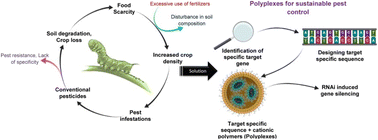The role of polyplexes in developing a green sustainable approach in agriculture
Abstract
Rise in global population has increased the food demands and thus the competition among farmers to produce more and more. In the race to obtain higher productivity, farmers have resorted to injudicious farming practices that include the reckless use of nitrogenous fertilizers and intensive cropping on farmlands. Such practices have paved the path for large scale infestations of crops and plants by pests thus affecting the plant productivity and crop vigour. There are several traditional techniques to control pest infestations in plants such as the use of chemical or bio-pesticides, and integrated pest management practices which face several drawbacks. Delivery of gene/nucleic acid in plants through genetic engineering approaches is a more sustainable and effective method of protection against pests. The technology of RNA interference (RNAi) provides a sustainable solution to counter pest control problems faced by other traditional techniques. The RNAi technique involves delivery of dsDNA/dsRNA or other forms of nucleic acids into target organisms thereby bringing about gene silencing. However, RNAi is also limited to its use because of their susceptibility to degradation wherein the use of cationic polymers can provide a tangible solution. Cationic polymers form stable complexes with the nucleic acids known as “polyplexes”, which may be attributed to their high positive charge densities thus protecting the exogenous nucleic acids from extracellular degradation. The current paper focuses on the utility of nucleic acids as a sustainable tool for pest control in crops and the use of cationic polymers for the efficient delivery of nucleic acids in pests thus protecting the plant from infestations.

- This article is part of the themed collection: 2022 Reviews in RSC Advances


 Please wait while we load your content...
Please wait while we load your content...